Making data findable, accessible, interoperable, and reusable

Researcher Brett Carr studies the nature of volcanic eruptions in Iceland.
When the University Libraries launched the Research Data Repository (ReDATA) in 2020, a primary goal was to help researchers and scholars amplify and share their work in different fields across the institution.
As ReDATA marks its fifth anniversary, we’re showcasing four researchers at the University of Arizona who have worked with the ReDATA team.
In the third part of our series, we look at the repository data review process.
Associate Specialist in Research Data Management Fernando Rios, and Data Repository Specialist Hafeez Adepoju work closely with researchers to ensure that funder, journal, and university data archiving and sharing requirements are met.
One essential step involves carefully curating and reviewing research data to prepare it for publishing, archiving, and sharing for future use. ReDATA’s commitment to align with the FAIR principles—making data findable, accessible, interoperable, and reusable—is vital to researchers and advancing research.
Brett Carr, a researcher and scientist in the Lunar and Planetary Laboratory in the U of A College of Science, studies the nature of volcanic eruptions.
"ReDATA solves the problem of where to archive data from my research following FAIR principles,” said Carr.
“Many public archives are for specific types or themes of data; with ReDATA, everything can go to the same place with clear organization amongst my projects.”
The data review process for researchers
- Prepare your dataset.
- Upload your dataset into ReDATA.
- Submit your dataset for curatorial review.
- Complete a deposit agreement and a readme form.
- We perform a curatorial review.
- If all curatorial concerns have been addressed, we publish your dataset and activate your unique Digital Object Identifier (DOI) for citation purposes.

After the curatorial review, the ReDATA team sends a report to the researcher that includes details about major issues and recommendations to resolve them.
Rios and Adepoju also lend their expertise by improving a researcher’s metadata, which explains the origin, purpose, time, geographic location, creator, access, and terms of use of the data. Their metadata support includes copyediting, adding related publications and presentations, and reorganizing files to make the data more findable.
Carr’s research centers on mapping classification and impacts of volcanic eruptions on Earth and Mars using different tools and methods from unoccupied aircraft systems to photogrammetric surveys. The data archived in ReDATA covers volcano sites in the Fagradalsfjall and Holuhraun regions in Iceland.
“I also like that it [ReDATA] is specifically a University of Arizona resource,” said Carr.
“The staff at University of Arizona Libraries have been essential in helping me prepare and organize thorough and properly documented data archives.”
Helpful tips
- Learn how to use ReDATA.
- Researchers can consult with the ReDATA team throughout the dataset review process.
- Datasets can be paused for publishing and archiving in ReDATA pending the publication of any associated journal articles.
Contact the ReDATA team at data-management@arizona.edu.
